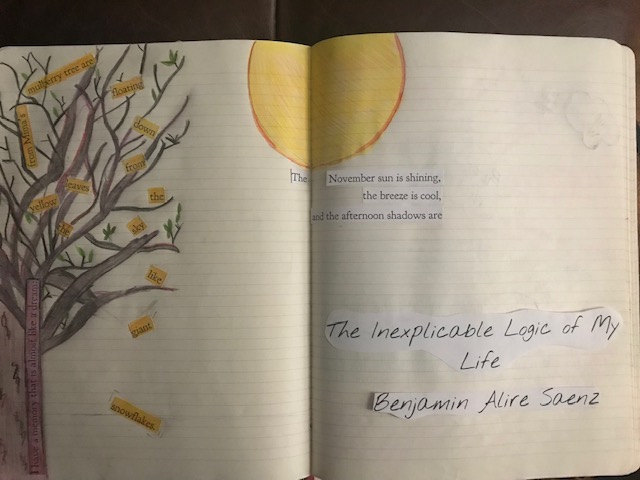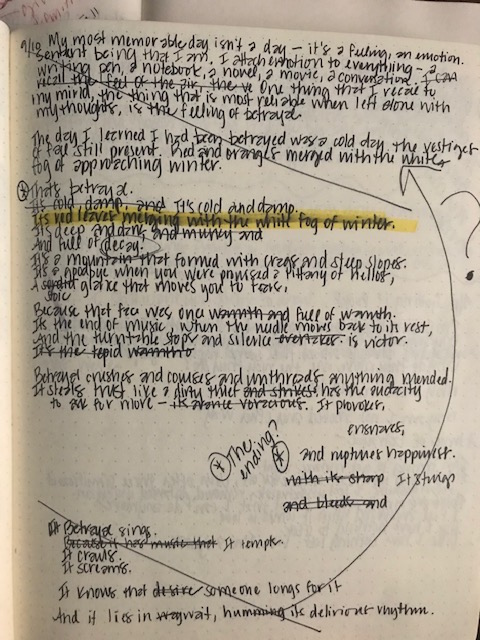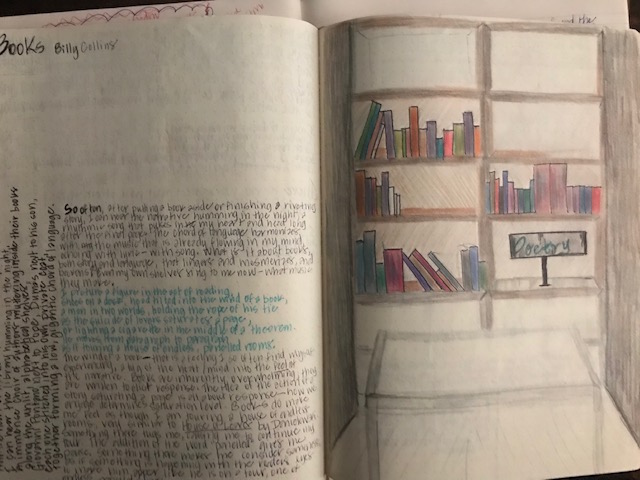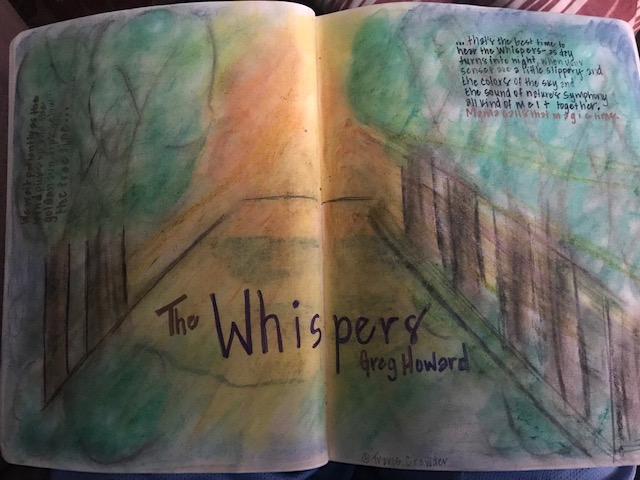“Reading is like breathing in, writing is like breathing out.” -Pam Allyn
“There are cracks in everything. That’s how the light gets in.” -Leonard Cohen
When I wrote the first part of this blog post, published in late November, I found ideas that I could not shake from my conscious mind. I composed my healing process in terms of books, but I could not speak fully to the experience of healing without mentioning the writing piece—my notebook. Reading was my saving grace during this past year, but my writing notebook became my safe space, the place where I could spill my emotions with impunity. As I devoured books, I collected my thinking in my notebook through reflection, character analysis, conversations with the authors, letters, and drawings. I established a healthy writing routine, too. Early in the mornings, as I sat listening to the whispers of a new day, I wrote and wrote. My reading life, fueled by a fervent visceral drive, needed a place to land. And it landed inside my notebook.
Over the course of the year, I watched as the landscape of my notebook changed. Because of my emotional trauma, my senses awakened more deeply—I noticed the poetry of sights, of sounds, of smells. I lingered in passages, in shades of meaning, in images and phrases; books gave me the language I needed to express myself when I felt that anguish had silenced them. Responses to language intensified and words transformed into sustenance. Writers seemed, through their poetry and prose, to extend their hands, full of lively language, and say, “Here. These are for you. Use them.” And I did. I filled my notebook with poems, quickwrites, and passages from books, something I had done before, but this time, I was crafting inside my notebook with a fervent purpose. When something in my reading life moved me, I photocopied it and affixed it to a page, underlining the pieces that spoke to me and writing my thinking beside those lines. I truly learned what it meant to write beside something, illustrating in a vibrant new way Penny Kittle’s concept of writing beside a text, which I thought I understood before, but now more truly grasp.
My notebook was no longer just a reaction to my reading. It became an existential reflection of me because I wasn’t just reading to fall in love with a book; I was reading to heal and understand myself. My writing became braver as I took risks with the art, the form, and the ideas I was willing to think about and craft. When thoughts exist in our minds, we can suppress them; however, writing them forces us to confront them. I was writing, but honestly, the words were writing me. As I composed, they lifted from the page and pulled the fragments of my heart together.
I first noticed changes in the artistry of my notebook this past summer. I read like a fiend, but the remarkable changes took time to notice. Writing always takes time. When we launched writing workshop in my classes this school year, I talked with students about patience. “We will write everyday,” I told them, “but it may not always be beautiful writing. You will struggle, you will procrastinate and possibly stare at the blankness of your screen and notebook, but writing each day will nourish your fledgling writing lives. You will craft plenty of things you are not comfortable sharing, but your confidence will grow as you continue to write. Sentences will be clunky, stories will be predictable, and you will wrestle with ideas and words. But this is part of the process and I need you to trust it and participate in it.” I could speak these words with a deeper confidence and conviction because I had watched my writing process evolve, strengthen, and move because I nourished it with daily writing and fueled it with heavy reading.

This word imagery spread was one of the first I created at the beginning of last year inside my writing notebook. I decided to abandon the stream-of-consciousness writing, which was the dominant form inside my notebook, and deconstruct a passage from The Inexplicable Logic of My Life by Benjamin Alire Saenz. I saw myself as the tree, nearly dead and losing the brightness that once resided there. This was a risk because it was a sharp contrast to the form I most often crafted in. Emotional pain had pulled me from the comfortable space I inhabited, and as a result, I wrote and crafted in a more abstract form.

I abandoned poetry several years ago, believing that my muse was dead and I had no reason to ever exhume such practice. After reading The Poisonwood Bible by Barbara Kingsolver, Housekeeping by Marilynne Robinson, and re-examining The Art of Description by Mark Doty, I decided to enter the world of poetry again. Here rests my thinking about betrayal, an idea I began wrestling with because of my own personal experience with the sharp pain of betrayal. Writing about my feelings gave me a front-row seat to the moment of betrayal, and although excruciating, I was able to step outside of the moment and view it as an observer. A different stance helped me heal because I could see it clearly through the lens of poetry. I’m not sure I understand why, but one day, I know I might.

Billy Collins’s poem “Books” was one of my favorites. It is a cerebral poem, one that begs re-reading. I am still not certain I understand his idea fully, but what I do know is that he captures so much about books and the act of reading. I was compelled by his poem to think about my own reading life and how reading moves me. A love of reading was often mocked and misunderstood in my past relationships. This poem helped me reconnect with the many reasons why books matter so much to me, even in the interim when I forgot how much I loved reading. I turned to art to express my thinking. When I collect student notebooks, I see they have taken me up on my offer to draw their thinking. And so often, like I do, they write beside their drawings.

I left this mortal plane to live in the fictive world of The Whispers. Written by Greg Howard, this gorgeous book transported me to the distant past and gave me the healing balm I needed to push through the last bits of emotional pain. His rich poetry and ideas are everything. And the story is exquisite. Words eluded me, but I could think through color. Language became art. When juxtaposed with the word imagery piece, my journey and willingness to create are apparent. The palette of color, the absence of white space, and the absence of words show my growth and experience. This is me, knowing I am stronger.
I wanted you to step inside my notebook with me. I wanted to give you a brief tour of the pieces that were a result of intense reading and daily writing. I wanted you to see that with time and patience, a writing notebook becomes a repository of thinking. And students need this. We get so caught up in the idea that writing has to be graded or evaluated by a rubric. But it’s the process of writing that helps us figure out what we have to say and how we can unpack our own thinking and feelings. Our kids are victimized by unfair writing instruction, and they believe that writing is only a form of assessment. What they don’t know and what we so often miss is that writing is thinking and heart work. Without that element of understanding, writing becomes another standard of learning, a useless measure of proficiency that will satisfy a checklist but not burst with life and passion inside our hearts. I gained a stronger understanding of what writing does because I wrote, not because of evaluation. Students—and adults—need to experience the same thing.
I share this deeply personal space with you because I am confident in the healing properties that writing and crafting afford. The more we write, the more we understand ourselves, and our journey is catalogued in the sentences and creations that fill the blank pages of a notebook. In the midst of heartache and pain, writing was my saving grace. Reading helped me heal, but I needed a place to exhale the wisdom, beauty, and hope I found in books. My notebook was that place. This past year was bitter and traumatic, but putting pen to paper each day breathed new life into my work as a teacher, writer, and human being. Writing helps us process emotion and trauma. It helps us learn, unpack, and explore our own interiority. Writing gives us a way to make meaning. That’s what it did for me, and I want students to know that the same process that helped me heal can help them. Life is so often unpredictable, and heartache has a way of metastasizing into an unbearable presence. Reading was my oxygen. Writing helped me learn to breathe again.
When I speak with students now about the writing process, I often put my writing notebook under the document camera and share with students my own writing, the raw and real, explaining to them where I started and how I wrote through the experience to heal and to understand. I ask them to embark on a similar journey of self-discovery through writing. I am speaking from the evolution of my writing notebook. I want students to know that writing is a way of knowing, a way of healing. And as they write, growing beside their thinking, I want them to see writing as a relevant method of excavating their own interior landscape, discovering the passageways out of seemingly insurmountable darkness. I want them to experience the freedom writing can bring.
So I ask you to pick up your pen, grab your notebook, start writing, and share your process with your students. There are cracks in the surfaces of our lives, but that’s part of the beauty of living. We read, breathing in story and borrowed sentences. Light shines, pressing into the broken parts. And we exhale with words and renewed ideas and the page before us illuminates.
T
Travis – wow, how powerful is this? First of all, thanks for sharing yourself in such a heartfelt way. This is so inspirational, especially heading back to school this week and meeting a new group of students to read and write with. I have written with my students during quick writes in my notebook, but nothing more than really taking my shoes off and dipping them in the pool. Reading this gives me the courage and, hopefully, the discipline from somewhere to jump all the way in and start writing every day.
“Reading helped me heal, but I needed a place to exhale the wisdom, beauty, and hope I found in books.” I’ve got the reading thing figured out, now I need to learn how to exhale and start getting it out on paper. Your wisdom and insight are the push into the deep end that I need.
Thanks, buddy. You continued to inspire me! – Brian
LikeLike
Travis,
Amazingly honest and heartfelt post. This is why writing teachers need to write. And to write beyond “stream-of-consciousness writing”! This really spoke to me: “Our kids are victimized by unfair writing instruction, and they believe that writing is only a form of assessment. What they don’t know and what we so often miss is that writing is thinking and heart work.” YES! Thank you for sharing your thinking and heart work!
LikeLike
Travis,
Thank you for sharing your experience, your pain, and your heart. But, more importantly, thank you for sharing your healing. I am reader and a writer who, over years of not fully processes emotional trauma, has lost both to the consumption of sadness and loneliness. The healing necessary has been elusive. My continued desire to grasp onto something led me to your blog post. Like a little salve on a wound, reading your blog has soothed it all a bit. That’s a start.
“There are cracks in everything. That’s how the light gets in.” -Leonard Cohen
I’ve tried to heal my cracks but not embraced the light those cracks have been trying to let in. I’m inspired because you shared. Thank you.
LikeLike